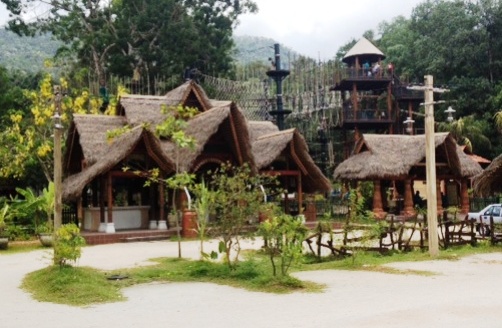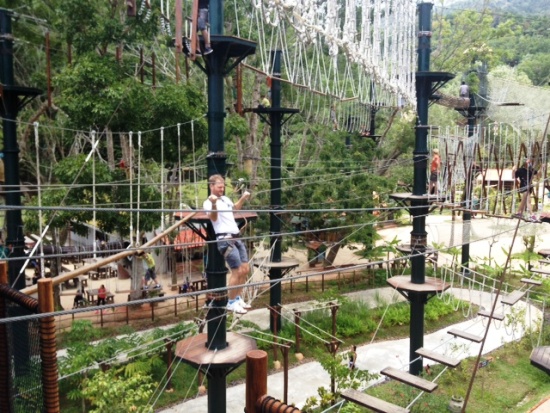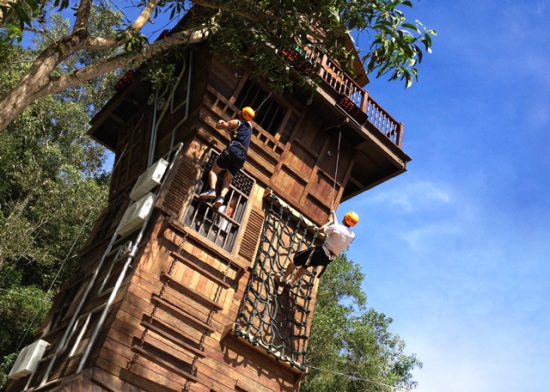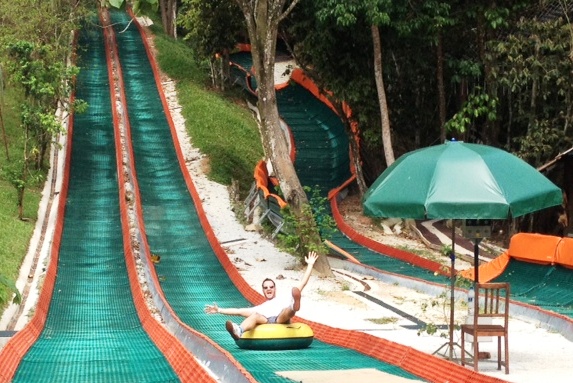
Penang is a green island in more than one sense of the word. Beyond the concrete suburbs that hug the eastern and northeastern coasts, much of the island is in fact covered in jungle and the local government is keen to promote its environmentally conscious side. The ‘
Cleaner Greener Penang’ campaign is visible everywhere, and there has been a huge effort in recent years to tidy up the streets, promote recycling and reduce pollution. Now Penang is championing the green cause in a whole new way with the opening of
Malaysia’s first environmentally friendly theme park, Escape.
Located about half an hour out of
Georgetown, in the jungles of the island’s northwest,
Escape is not a theme park in the traditional saccharine-coated, plastic-fantastical sense. Forget about cuddly life-size cartoon characters, spinning teacups, replica fibreglass world monuments and rollercoasters. Escape offers a completely different experience, which eschews almost all the values of your typical amusement park.
Instead of trying to transport visitors to a land of fabricated fantasies, it draws you into the world that already exists around you. The theme at Escape is ‘natural’, and the emphasis is on connecting with others, as well as capturing a sense of adventure. Rising organically out of the surrounding jungle, the park aims to be as environmentally friendly as possible. The traditional thatched kampong-style buildings that greet you when you enter the park are the real deal, and the grass roofs, recycled water system and ‘human-powered’ attractions all help the park integrate into its natural surroundings.

Another major attraction is the
Tubby Racer, where you can hurl yourself down a hillside in a large rubber tyre. On our recent visit we couldn’t understand why there were no queues, but the climb to the top, dragging your tyre behind you, obviously puts more than a few people off. It requires some stamina, but the buzz of the downward descent is worth it. Other popular attractions are the bungee jump platform, Atan’s Leap, as well as the Gecko Tower, where you can pit yourself against the clock, and other contenders, to haul yourself to the top of the tower as fast as possible.
There are loads of activities to keep children entertained, too, from negotiating the Tots Trail, foraging for treasure at the Discovery Dig, or squeezing through a series of tunnels and mazes in Foxy Burrow. An extensive play area will occupy younger children, and there’s picnic areas and even treetop day cabanas, which can be rented for between 50 and 150 ringgit per day and provide a quiet respite from all that activity and adventuring.

The feel inside the park is at once organic, but with nods to the traditional theme park in terms of the map, the names of the attractions and the general ambience. Hits from the eighties, nineties and noughties play over the park’s loudspeakers, and there is a food court serving canned drinks (4 ringgit), bottles of water (2.50 ringgit) and fresh fruit juices (5 to 6 ringgit), as well as various Chinese, Malay and Western snacks and meals including burgers, chicken rice, spring rolls, noodles and sandwiches, for between 8 and 16 ringgit.
The park works on a ‘no-cash’ basis for food purchases, so you will need to deposit money on a special card, for which you pay a deposit of 5 ringgit (you can top this up if you need to, and any unused credit, plus the deposit, is refunded at the end of your visit). No food or drinks can be taken into the park, but you can bring water bottles and refill these, and if you need to store bags and belongings, lockers can be rented near the reception area for 5 ringgit.

Entrance is 60 ringgit for adults and 45 ringgit for under-12s and over-60s. Three to four hours would be enough to get your money’s worth, although if you want to factor in some relaxation time and rent one of the cabanas, or if you just want to take your time and let the kids run around a bit, then you could easily spend the day here. Buses 101 and 102 to Teluk Bahang depart regularly from the bus station at Weld Quay, or a taxi should cost around 60 to 70 ringgit.
In 2014,
Escape will be extended to include a waterpark and hotel, though whether these follow the same environmentally friendly theme remains to be seen. Regardless of this, the Adventureplay section offers a very active antidote if you have overdosed on too much
Penang food and culture. The fact that it operates on such admirable principles, and is so different to anything else in Malaysia, is reason to visit in itself. Be prepared to expend a lot of energy and get very sweaty, but if you just need to let off some steam, this really is a rewarding way to do so.

 In our dairy milk production, hygiene is very important. This Penang Goat Farm uses minimal human handling and most of the processes are automated including the milking process.
In our dairy milk production, hygiene is very important. This Penang Goat Farm uses minimal human handling and most of the processes are automated including the milking process.
 Happy Goats is the pioneer in goat farming using close house climate control barn. The benefit of using this system is these animals are not exposed to harmful virus and bacteria from other animal. By using this method of farming the farm are able to be kept clean with minimum usage of water and the animals would be in their natural environment as the temperature in the barn is kept cool similar to the weather in Australia. As such we are able to bring the best breed of Saanan dairy goat from Australia to our farm in Balik Pulau, Penang, Malaysia.
Happy Goats is the pioneer in goat farming using close house climate control barn. The benefit of using this system is these animals are not exposed to harmful virus and bacteria from other animal. By using this method of farming the farm are able to be kept clean with minimum usage of water and the animals would be in their natural environment as the temperature in the barn is kept cool similar to the weather in Australia. As such we are able to bring the best breed of Saanan dairy goat from Australia to our farm in Balik Pulau, Penang, Malaysia.






